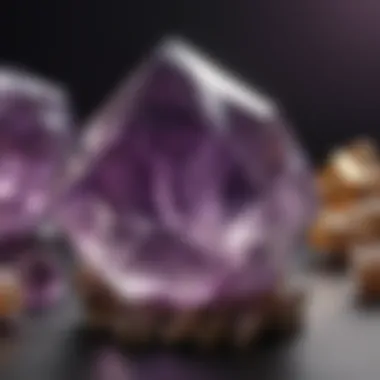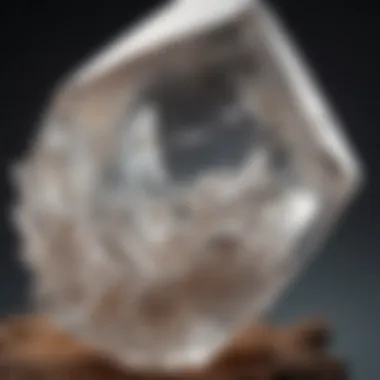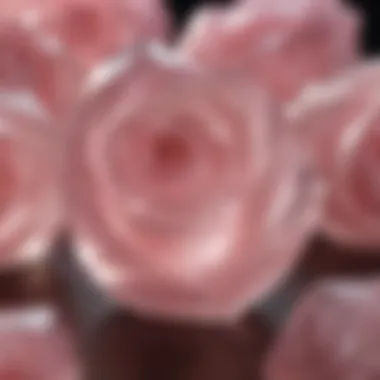Exploring Crystals: Images and Their Deep Meanings


Intro
Rock and Fossil Identification
Identifying various crystals is essential for any serious collector. Each type possesses distinct characteristics. When attempting to identify crystals, collectors should focus on the following:
Types of Crystals
There are numerous types of crystals, but a few stand out due to their unique properties and meanings:
- Amethyst: Known for its calming effects, often associated with spiritual growth.
- Quartz: The most common crystal, recognized for its clarity and versatility in energy amplification.
- Citrine: Frequently linked to prosperity and positivity.
Characteristics to Look For
Identifying crystals involves observing specific physical traits as follows:
- Color: Crystals come in a variety of colors. The color can indicate the type of crystal and its meaning.
- Clarity: The level of transparency can vary; more transparent crystals are often more sought after.
- Inclusions: Imperfections within the crystal can provide clues to its authenticity and origin.
Tools for Identification
Utilizing the right tools enhances the identification process:
- Loupe or magnifying glass: Helps in examining fine details.
- Field guide: Reference books provide context about local varieties and their meanings.
- Gem tester: Electronic devices can determine the stone's properties more accurately.
Understanding the characteristics of each crystal type brings clarity to collectors and helps in making informed choices when acquiring specimens.
Collecting Tips and Techniques
Collecting crystals is a rewarding endeavor, but it demands knowledge and skill.
Best Practices for Collecting
- Always obtain permission before collecting from private lands.
- Leave no trace; respect nature to preserve sites for future collectors.
Locating Prime Collecting Sites
Prime locations for crystal hunting include:
- Gem shows: These events often have a variety of vendors showcasing unique specimens.
- Mining sites: Some abandoned mines allow the public to explore and collect.
- Natural settings: Local public lands or national parks may yield natural finds.
How to Safely Extract Specimens
Safety is paramount when collecting:
- Use appropriate tools such as chisels and hand picks.
- Wear protective gear, including gloves and safety glasses, to minimize risk of injury while extracting.
Preservation and Display
Once crystals are collected, preserving their quality is crucial.
Techniques for Preserving Crystals
- Store crystals in a cool, dry place to prevent degradation.
- Avoid exposing them to direct sunlight for prolonged periods.
Proper Storage Methods
- Use padded boxes or cloth bags to prevent scratches.
- Keep similar types of crystals together to avoid confusion.
Creative Display Ideas
- Utilize decorative glass cases to showcase your collection while protecting it from dust.
- Consider thematic arrangements that tell a story or illustrate a particular characteristic.
Geological Insights


To fully appreciate the significance of crystals, understanding their geological background is beneficial.
Geological Formations and Processes
Crystals form through various geological processes, often taking thousands of years. This can include:
- Igneous processes: Crystals crystallize from molten rock.
- Sedimentary processes: Weathering and calcification can lead to crystal formation over time.
Historical Significance of Crystals
Crystals have featured prominently in many cultures, often regarded as symbols of power or healing. For instance, civilizations such as the Ancient Egyptians valued lapis lazuli and turquoise, integrating them into jewelry and artifacts, thus cementing their historical importance.
Notable Discoveries in the Field
Crystallography continues to evolve. Noteworthy finds include:
- Rare specimens such as the giant quartz crystal cluster discovered in the caves of Brazil.
- Unique formations like the giant geodes found in Naica, Mexico, which provide insight into geological processes.
Prolusion to Crystals
Exploring the realm of crystals is both fascinating and enlightening. Crystals are more than just attractive physical specimens; they hold meaning and significance across cultures. Understanding crystals is essential for anyone interested in geology, metaphysics, or even spirituality. This section lays the groundwork for the discussions to come, providing a comprehensive introduction to what crystals are and why they matter.
Definition and Formation
Crystals are solid materials whose atoms are arranged in a highly ordered structure, forming a crystal lattice. This arrangement leads to their unique shapes and properties. Different minerals form crystals in various ways, influenced by factors such as temperature, pressure, and the chemical environment. For instance, quartz, one of the most common crystals, forms when silica-rich solutions cool and crystallize.
Crystals can be categorized based on their formation processes:
- Igneous crystals form from cooled magma or lava.
- Metamorphic crystals arise from existing minerals that undergo pressure and heat changes.
- Sedimentary crystals develop through evaporation or precipitation in solution.
Understanding these definitions and formations helps collectors appreciate the natural processes that create these stunning objects.
Historical Significance
The significance of crystals transcends mere aesthetics. Historically, they have been viewed as symbols of power, protection, and healing. Ancient civilizations used crystals for various purposes, including spiritual rituals, healing practices, and as currency in trade. For instance, the Egyptians believed in the protective power of stones like lapis lazuli and turquoise. This historical context is crucial for modern collectors, as it provides insight into the perceived value and uses of crystals across different cultures and times.
Crystals have also played roles in traditional medicine. In various cultures, certain stones are thought to possess healing properties. For example, amethyst has been used to promote calmness, while rose quartz is associated with love and compassion. This cultural significance enriches the narrative surrounding crystals, making them not only collectibles but also vessels of historical and spiritual importance.
"Understanding crystals means engaging with a historical narrative that connects us to the past and enlightens our present."
Understanding Crystal Meanings
Understanding the meanings associated with crystals is essential in appreciating their significance in various contexts. This section explores the layers of interpretation and energy these stones possess. Knowing the meanings can aid collectors in making informed decisions about their selections, whether for aesthetic appeal or deeper spiritual purposes.
The Concept of Crystal Energies
The idea of crystal energies stems from the belief that crystals emit specific vibrations. Each type of crystal has a unique energy pattern, influenced by its chemical structure, crystalline form, and color. This energy interaction can resonate with human emotions, intentions, and physical states.
Furthermore, enthusiasts often believe that these vibrations can facilitate healing, personal growth, or protection. For instance, Amethyst is regarded for its calming effects, while Citrine is said to promote abundance and success. Collectors often seek to harness these energies in their daily lives, using them during meditation or displaying them in their homes for positive influence. Hence, understanding these energies allows collectors to connect more profoundly with their crystals and maximize their potential benefits.
Cultural Variances in Interpretation
The interpretations of crystals vary significantly across different cultures and historical contexts. These variances highlight the diverse beliefs held about the properties and powers of crystals.
- Ancient Civilizations: In ancient Egypt, crystals were often embedded in tombs for protection in the afterlife. The Egyptians revered Lapis Lazuli, considering it a stone of royalty and power.
- Eastern Traditions: In many Asian cultures, crystals are utilized in spiritual practices. For instance, in Traditional Chinese Medicine, certain crystals are used for balancing Chi, the life force energy.
- Modern Spirituality: In contemporary practices, such as crystal healing, the meanings attributed to stones often derive from a mix of historical interpretations and personal experiences.
Understanding these cultural interpretations helps collectors appreciate the broader significance of their stones. It allows them to transcend mere aesthetics, seeing each crystal as an embodiment of historical beliefs and practices. This perspective enhances both their value and the collector's experience.
Common Types of Crystals
In the realm of crystals, understanding the common types becomes paramount. Each type comes with its unique properties and meanings, making them valuable for various applications. For collectors and enthusiasts alike, recognizing these crystals is not just about their physical appearance but also about their historical and metaphysical significance. This section will explore five prominent types of crystals: Quartz, Amethyst, Rose Quartz, Citrine, and Obsidian. Examining these crystals offers insight into their relevance in areas ranging from healing practices to aesthetic appreciation.
Quartz
Quartz is perhaps the most abundant mineral found in the Earth's crust. It has a reputation for clarity and versatility. Quartz comes in many forms, with clear quartz being particularly popular due to its ability to amplify energy. This characteristic makes it a favored choice in meditation and healing. Moreover, quartz is linked to clarity of thought and is often used to enhance focus during mindfulness practices.


Amethyst
Amethyst stands out with its rich violet hue. Historically, this crystal was regarded as a stone of protection and wisdom. Many believe it possesses calming properties, aiding in stress relief and emotional balance. Its association with the crown chakra enhances spiritual growth and connection. Collectors value amethyst not only for its beauty but also for its reputed ability to improve intuition and enhance meditative practices.
Rose Quartz
Rose Quartz is often called the "stone of love". Its gentle pink color symbolizes affection, compassion, and self-love. This crystal is commonly utilized in healing practices to promote emotional healing and foster meaningful relationships. Many collectors find rose quartz appealing for both its aesthetic charm and its powerful energy of love and harmony. It holds a special place in both personal and spiritual development.
Citrine
Citrine is a vibrant yellow to brownish orange variety of quartz. Often associated with prosperity, joy, and abundance, this crystal is popular among those seeking to attract wealth and success. Citrine is also known for its energizing properties, revitalizing the spirit and promoting positive thoughts. Its sunny disposition makes it an appealing choice for those looking to enhance their motivation and creativity.
Obsidian
Obsidian is a natural volcanic glass with a deep black color and smooth texture. It is associated with protection and grounding. Many believe it can help in revealing hidden emotions and fostering self-reflection. Obsidian is often used as a tool for spiritual cleansing, helping to shield against negativity. Collectors appreciate its unique formation and powerful energies, which contribute to its standing in various cultural practices.
The allure of these common crystals lies not only in their beauty but in their profound meanings and uses across history and cultures.
Visual Guide to Crystals
The visual representation of crystals is an essential aspect of understanding their meanings and significance. In this section, we will explore how photographs and artistic renderings of crystals serve as not just aesthetic features, but as tools for education and appreciation. These visuals aid both enthusiasts and collectors in recognizing the unique traits of each crystal, fostering a connection that goes beyond superficial beauty.
Photographic Representations
Photographic representations provide clear and detailed views of crystals in their natural state. These images capture the unique colors, shapes, and textures that define each crystal species. High-quality photographs allow collectors to appreciate the intricate patterns and reflections of light, which contribute to each crystal's allure.
Moreover, photographs can serve as reference points for identification. For new collectors, seeing a well-captured image can help distinguish between similar types of crystals. For instance, the vibrant hues of an amethyst stand out in vivid photographs compared to lesser-known specimens like fluorite.
"A photograph is worth a thousand words, especially when trying to discern the subtle differences between crystal types."
This is especially true in online environments where interaction is limited. Visuals become vital in conveying information that might otherwise be lost in explanatory text. Everyone, from seasoned experts to beginner enthusiasts, can benefit from such clarity.
Artistic Interpretations
Artistic interpretations of crystals offer a different perspective. They do not aim for realism but rather explore deeper meanings or cultural contexts related to the crystals. Artists often use crystals as symbols, reflecting their properties in unique ways. Such representations can include paintings, drawings, or geometric designs incorporating crystals.
These artworks can evoke emotions or spark curiosity about the metaphysical attributes attributed to specific crystals. An artist's imagination can interpret quartz as a source of clarity or serenity. Thus, these interpretations expand the viewer's understanding of crystals beyond their physical form.
In addition, displaying artwork featuring crystals can enhance the ambiance of personal spaces, making them more inviting and reflective of one's interests. Engaging with artistic interpretations encourages meaningful dialogues about each crystal's story and significance throughout various cultures and periods.
By combining photographic representations with artistic interpretations, the visual guide to crystals presents a fuller understanding. Both methods of representation invite a deeper exploration into the crystals' meanings and enhance the enjoyment of collecting.
Crystals in Meditation and Healing
The integration of crystals into meditation and healing practices is a significant aspect of the exploration of their meanings. This section elaborates on how specific crystals are not merely decorative but serve essential roles in enhancing mindfulness and promoting well-being. Many enthusiasts and practitioners believe that crystals possess unique energies that can influence one's emotional and physical state. Understanding how to utilize these tools can enrich personal practices and provide profound benefits.
Utilization in Mindfulness Practices
Mindfulness practices often invoke various techniques aimed at fostering a deeper sense of awareness and presence. Crystals can amplify these experiences through their unique properties. For example, amethyst is commonly referred to for its calming effects. Placing it within your environment or holding it during meditation may help to clear the mind.
Here's how crystals can be used in mindfulness:
- Set Intentions: Before meditation, hold the crystal in your hand and focus on your intentions for the session. This connection can enhance your meditative focus.
- Create a Space: Arranging crystals around your meditation area can create a serene environment, which aids in concentration.
- Use During Breathing Exercises: Holding a crystal while practicing deep breathing can provide a tactile anchor, drawing your attention to the present moment.
Healing Properties Explained
Crystals are believed to hold various healing properties that can support mental and physical health. Each type of crystal is thought to resonate with different energies, thus influencing the user in distinct ways. Understanding these properties can help individuals choose the right crystals for their needs.
For instance:
- Rose Quartz: Known as the stone of love, it promotes self-love and emotional healing. It's often utilized to soothe the heart and encourage self-acceptance.
- Black Tourmaline: Commonly used for grounding and protection. Many individuals place this crystal in their space to repel negative energy and promote a sense of security.
- Citrine: Often associated with abundance and positive energy. It can be used during manifestations or abundance meditations.
"Choosing a crystal for healing is a personal journey, and it should reflect one's unique needs and emotional state."


As rock and fossil collectors delve deeper into the world of crystals, possessing knowledge about their healing properties can enhance their collecting experience. Knowing how to integrate these minerals into daily practices opens avenues for both spiritual and physical well-being.
Collecting Crystals
Collecting crystals offers a unique blend of artistry, history, and science. It enables enthusiasts to appreciate not just the beauty of these stunning specimens but also the stories they tell and the energies they embody. For many, the thrill of uncovering rare pieces is both a hobby and a passion. Knowing how to collect responsibly and systematically can enhance this experience significantly.
Ethical Considerations in Collection
When it comes to collecting crystals, ethical sourcing is essential. Many collectors are motivated by the desire to own aesthetically pleasing specimens. However, this must be balanced with consideration for the environmental and social impact of mining operations.
- Responsible Sourcing: Ensure that your crystals come from suppliers who adhere to ethical mining practices. This can help minimize damage to the environment and local ecosystems.
- Cultural Awareness: It’s important to respect the cultural significance of certain crystals, especially those tied to indigenous communities. Misappropriation can lead to cultural insensitivity and exploitation.
- Sustainable Practices: Choose crystals that are ethically sourced or lab-grown. This not only supports sustainability but also reflects a commitment to responsible collecting.
By staying informed and aligning with ethical guidelines, collectors can preserve the natural beauty and integrity of crystal collecting for future generations.
Organizing and Preserving Crystals
Once you embark on your journey and begin to accumulate crystals, proper organization and preservation become key tasks. Effective organization helps in appreciating each piece and enhances the overall experience of crystal collecting.
- Display Techniques: Use shelves or display cases that allow visibility while protecting the crystals from dust and damage. Clear containers can also assist in showcasing individual pieces well.
- Labeling: Keep track of each crystal's provenance and meaning by labeling them. This can include the name, origin, and any personal notes about the specimen's purpose or significance to you.
- Environmental Factors: Ensure that crystals are stored away from direct sunlight. Prolonged exposure can cause fading or damage to certain types. Maintaining a stable temperature and humidity level also prolongs their lifespan.
Tip: Regularly clean your crystals using appropriate methods to keep them in prime condition. Be cautious with the materials used to avoid scratches or degradation.
Myths and Misconceptions
Understanding myths and misconceptions surrounding crystals is crucial for anyone interested in their meanings and values. This section aims to clarify common beliefs and ideas that have been passed down through various cultures. By addressing these misconceptions, we can cultivate a more accurate understanding of crystals and their properties.
Debunking Common Myths
There are several myths about crystals that persist in public consciousness. One common myth is that certain crystals can directly cure illnesses. While some proponents of crystal healing report positive experiences, it is vital to realize that crystals should not replace traditional medicine. Instead, they can serve as a complementary practice.
Another myth involves the idea that crystals possess magical powers. This notion is likely rooted in ancient belief systems and folklore. However, scientific inquiry does not support these claims. The benefits derived from crystals typically relate to calming effects or positive affirmations rather than any supernatural ability.
People often believe that the more expensive the crystal is, the better it will work. This is not necessarily true. The effectiveness of a crystal is subjective, depending more on individual perception and intention rather than its price or rarity.
- Common myths include:
- Crystals can cure diseases: Crystals serve as a complement to health practices but do not replace medical treatments.
- They possess inherent magical powers: Benefits from crystals are more psychological than mystical.
- More expensive equals better: The personal connection to a crystal often matters more than its monetary value.
Understanding the Science Behind Crystals
To appreciate the role of crystals accurately, it is necessary to discuss the scientific aspects. Crystals are solid substances made of atoms arranged in a highly ordered microscopic structure, forming a crystal lattice. The science of crystallography studies these structures. It can help explain why certain crystals might produce specific responses in people.
For instance, quartz is known for its ability to store and conduct energy. This property stems from its molecular structure. When subjected to pressure, quartz generates an electrical charge. This is the principle behind quartz watches, where the crystal's vibrating properties regulate time.
Moreover, much of the appeal of crystals comes from their aesthetic quality and the captivating manner in which they reflect light. These physical attributes can evoke emotional responses and a sense of connection.
In summary, while crystals may not have the mystical properties often attributed to them, their physical and energetic characteristics warrant study. Understanding both the myths and the science allows enthusiasts to appreciate crystals more fully, cultivating a balanced approach to their collection and use.
Concluding Thoughts
The exploration of crystals and their meanings is an intricate discipline, interwoven with history, culture, and personal practice. Understanding this subject allows individuals to appreciate not only the visual beauty of crystals but also their profound significance. When collectors and enthusiasts engage deeply with this topic, they gain insights into the metaphysical properties that many believe crystals hold. This understanding can lead to more intentional choices when acquiring new specimens.
The Future of Crystal Collecting
Looking ahead, the future of crystal collecting appears bright. As more people become aware of the holistic benefits and aesthetic value of crystals, the community is growing. Significant technological advancements in mining, combined with an increased focus on sustainability, may shift the ways collectors source their crystals.
- Sustainability: There is a rising trend towards environmentally friendly practices in crystal collecting. Collectors are looking for ethically sourced crystals, which can reduce the environmental impact associated with mining.
- Technology: Digital platforms are making it easier for collectors to find and share information. Online marketplaces, such as Facebook groups and reddit forums, facilitate expansive discussions on crystal care, properties, and ethical sourcing.
- Education: Workshops and seminars are becoming more common, emphasizing the educational aspect of crystal collecting. As people learn more, they become more responsible collectors, enhancing the community's overall standard.
Adopting these practices ensures that the future of crystal collecting is not only sustainable but also enriches the collecting experience.
Encouraging Knowledge Sharing and Community
Fostering a culture of knowledge sharing within the crystal community is paramount. The exchange of information cultivates a more informed and cohesive group. Sharing experiences with others can provide new insights on technique and care, enhancing the overall collecting process.
- Community Forums: Platforms such as reddit and Facebook groups enable individuals to connect over shared interests. Participating in discussions can illuminate lesser-known facts about different crystals and their uses.
- Local Meetups: Engaging with local collectors through meetups can create stronger connections and foster friendships rooted in shared passions. In-person events can bolster collaboration, leading to knowledge sharing that benefits all members.
- Resource Sharing: Creating a repository of resources, such as articles, photos, and personal experiences, will benefit both seasoned collectors and newcomers. It can serve as a foundation for informed discussions.
The bonds built through shared knowledge strengthen the community, providing a network for support and celebration of diverse perspectives.
"Knowledge is the cornerstone of progress; sharing it widens the horizon of understanding."
By emphasizing these aspects, collectors can help ensure that the world of crystals remains vibrant and intellectually rewarding.







